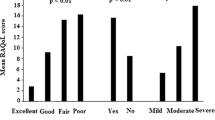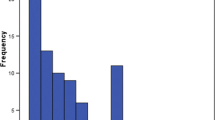Abstract
Pain in RA is multifaceted and complex. Measuring instruments are inadequate. Rheumatoid Arthritis Pain Scale (RAPS) (Arthritis Care Res 45:317–323, 2001) was designed to measure pain comprehensively but has been sparsely reported. We decided to validate a suitable version for our community. Post translation (contextual), RAPS was administered (face to face interview) to 172 consenting patients of moderately severe RA (mean pain visual analogue scale (VAS) 5.4 cm) in a cross-sectional study using standard rheumatology case record form. RAPS contained 24 questions (numeric score, anchored at 0 (never) and 6 (always); range 0–144). Fifty-seven cohort patients on supervised rheumatology care were followed for 16 weeks. SPSS (v16) was used for statistical analysis, significant p < 0.05. RAPS showed good face and content validity (consensus). Construct/criterion validity was demonstrated for subclass domains and total RAPS (Cronbach’s alpha 0.91, test–retest interclass correlation (Pearson) 0.71). Fair to modest correlation (p < 0.05) was seen with swollen joint count (0.16), Indian health assessment questionnaire (0.23), medical outcome short form (SF), 36 physical score (−0.35), SF 36 mental score (−0.21) and C-reactive protein (0.25), not with pain VAS. Similar results were shown for subclass domains (physiologic, affective, sensory, cognitive), except low alpha for affective. Age, disease duration and SF 36 were significant predictors (linear regression). In factor analysis, RAPS loaded with SF 36. The standardized response mean (0.6) was equal to pain VAS and DAS 28. RAPS was found to be a valid and clinically relevant instrument for measuring pain in Indian patients suffering from RA. It merits more widespread clinical use.
Similar content being viewed by others
References
Sokka T (2003) Assessment of pain in rheumatic diseases. Clin Exp Rheumatol 23:S77–S84
Buckelew SP, Parker JC (1989) Coping with arthritis pain: a review of the literature. Arthritis Care Res 2:136–145
Minnock P, FitzGerald O, Bresnihan B (2003) Women with established rheumatoid arthritis perceive pain as the predominant impairment of health status. Rheumatology 42:995–1000
Skevington S (1986) Psychological aspects of pain in rheumatoid arthritis: a review. Soc Sci Med 23:567–575
Kremer JM, Genant HK, Moreland LW, Russell AS, Emery P, Abud-Mendoza C et al (2006) Effects of abatacept in patients with methotrexate-resistant active rheumatoid arthritis. Ann Intern Med 144:867–876
Felson DT, Anderson JJ, Boers M, Bombardier C, Chemoff M, Fried B et al (1993) American College of Rheumatology preliminary core set of disease activity measures for rheumatoid arthritis clinical trials. Arthritis Rheum 36:729–740
Carlsson AM (1983) Assessment of chronic pain. I. Aspects of the reliability and validity of the visual analogue scale. Pain 16:87–101
Huskisson EC (1974) Measurement of pain. Lancet 2:1127–1131
Huskisson EC (1982) Measurement of pain. J Rheumatol 9:768–769
Turk D, Melzack R (1992) Handbook of pain assessment. The Guilford Press, New York
Hawker GA, Mian S, Kendzerska T, French M (2011) Measures of adult pain: Visual Analog Scale for Pain (VAS Pain), Numeric Rating Scale for Pain (NRS Pain), McGill Pain Questionnaire (MPQ), Short-Form McGill Pain Questionnaire (SF-MPQ), Chronic Pain Grade Scale (CPGS), Short Form-36 Bodily Pain Scale (SF-36 BPS), and Measure of Intermittent and Constant Osteoarthritis Pain (ICOAP). Arthritis Care Res (Hoboken) 63(Suppl 11):S240–S252
Fries JF, Spitz P, Kraines RG, Holman HR (1980) Measurement of patient outcome in arthritis. Arthritis Rheum 23:137–145
Meenan RF, Gertman PM, Mason JH (1980) Measuring health status in arthritis: the arthritis impact measurement scales. Arthritis Rheum 23:146–152
Ware JE, Sherbourne CD (1992) The MOS 36-item short-form health survey (SF-36): conceptual framework and item selection. Med Care 30:473–483
Tugwell P, Idzerda L, Wells GA (2007) Generic quality-of-life assessment in rheumatoid arthritis. Am J Manag Car 13:S224–S236
Callahan LF, Brooks RH, Summey JA, Pincsu T (1987) Quantitative pain assessment for routine care of rheumatoid arthritis patients, using a pain scale based on activities of daily living and a visual analog pain scale. Arthritis Rheum 30:630–636
Melzack R (1975) The McGill Pain Questionnaire: major properties and scoring methods. Pain 1:277–299
Melzack R (1987) The Short-Form McGill Pain Questionnaire. Pain 30:191–197
Anderson LD (2001) Development of an instrument to measure pain in rheumatoid arthritis. Rheumatoid Arthritis Pain Scale (RAPS). Arthritis Care Res 45:317–323
Centre for Rheumatic Diseases, Pune [Internet. Accessed March 15, 2015.] Available from: www.rheumatologyindia.org.
Kianifard T, Saluja M, Chopra A (2014) Is dietary potassium important in rheumatoid arthritis? Preliminary observations. Ann Rheum Dis 73(Suppl_2):1169–1170
Arnett FC, Edworthy SM, Bloch DA, McShane DJ, Fries JF, Cooper NS et al (1988) The American Rheumatism Association 1987 revised criteria for the classification of rheumatoid arthritis. Arthritis Rheum 31:315–324
Chopra A, Saluja M (2012) Validation and usefulness of an Indian version (CRD Pune) health assessment questionnaire: drug trials, community practice and COPCORD Bhigwan population study (1994-2012). Indian J Rheumatol 7:74–82
Ware JE, Kosinski M, Dewey JE (2000) How to score version two of the SF-36 health survey. Quality Metric, Lincoln
Portney LG, Watkin MP (2000) Foundations of clinical research. Applications to practice, 2nd edn. Prentice Hall Health, New Jersey, pp 79–110
Boers M, Brooks P, Strand CV, Tugwell P (1998) The OMERACT filter for outcome measures in rheumatology. J Rheumatol 25:198–199
Burckhardt CS, Jones KD (2003) Adult measures of pain. The McGill Pain Questionnaire (MPQ), Rheumatoid Arthritis Pain Scale (RAPS), Short-Form McGill Pain Questionnaire (SF-MPQ), Verbal Descriptive Scale (VDS), Visual Analog Scale (VAS), and West Haven-Yale Multidisciplinary Pain Inventory (WHYMPI). Arthritis Rheum (Arthritis Care Res) 49(5S):S96–S104
Melzack R, Dennis S (1979) Pain mechanisms: theoretical approaches. In: Beers RF, Basset EG (eds) Mechanisms of pain and analgesic compounds. Raven, New York, pp 185–187
ten Klooster PM, Vlaar APJ, Taal E, Gheith RE, Rasker JJ, El-Garf AK et al (2006) The validity and reliability of the graphic rating scale and verbal rating scale for measuring pain across cultures: a study in Egyptian and Dutch women with rheumatoid arthritis. Clin J Pain 22:827–830
Vlaar APJ, ten Klooster PM, Taal E, Gheith RE, El-Garf AK, Rasker JJ et al (2007) A cross-cultural study of pain intensity in Egyptian and Dutch women with rheumatoid arthritis. J Pain 8(9):730–736
Cornelissen PGJ, Rasker JJ, Valkenburg H (1988) The arthritis sufferer and the community: a comparison of arthritis sufferers in rural and urban areas. Ann Rheum Dis 47:150–156
Chopra A (2009) Community rheumatology in India. Indian J Rheumatol 4:119–126
Sim J, Waterfield J (1997) Validity, reliability and responsiveness in the assessment of pain. Physiother Theory Pract 13:23–38
Englbrecht M, Tarner IH, van der Heijde DM, Manger B, Bombardier C, Müller-Ladner U (2012) Measuring pain and efficacy of pain treatment in inflammatory arthritis: a systematic literature review. J Rheumatol Suppl 90:3–10
Acknowledgments
We thank the management of ARCF-CRD for this in-house PhD research project and all patients who participated in the study and its validation process. Dr S Sarmukkadam, a biostatistician, provided excellent statistical guidance and analysis. Several colleagues, namely Dr Nachiket Kulkarni, Ms Manjit Saluja and Dr N Nahar, from CRD Pune assisted in screening and enrolling patients, rheumatology examination and co-ordination of the project. Dr Anuradha Venugopalan, in charge at the lab and an immunologist, provided an invaluable assistance in carrying out the study laboratory tests.
Authors’ contributions
All the authors were involved in drafting the manuscript and approved the final version. Dr Arvind Chopra had full access to the data and takes full responsibility for the veracity of the data in the current study. Toktam Kianifard, Taghi Kianyfard and Arvind Chopra are responsible for the study concept and design. Toktam Kianifard and Arvind Chopra are responsible for the acquisition of data. Toktam Kianifard and Arvind Chopra are responsible for the analysis and interpretation of data.
Financial sponsorship/grant
None.
Compliance with Ethical Standards
ᅟ
Disclosures
None.
Author information
Authors and Affiliations
Corresponding author
Appendix
Appendix
Rheumatoid Arthritis Pain Scale [19].
For each item, choose one number from 0 (never) to 6 (always) to describe how you have felt in the last week. 0 1 2 3 4 5 6
1. I would describe my pain as gnawing. (S)
2. I would describe my pain as aching . (S)
3. I would describe the word exhausting to describe my pain (A)
4. I would describe my pain as annoying. (A)
5. I’m in constant pain. (S)
6. I would describe my pain as rhythmic. (S)
7. I have swelling of at least one joint. (P)
8. I have morning stiffness of one hour or more. (P)
9. I have pain on motion of at least one joint. (P)
10. I cannot perform all the everyday tasks I normally would because of pain. (C)
11. Pain interfere with my sleep. (C)
12. I cannot decrease my pain by using methods other than taking extra medication. (C)
13. I would describe my pain as burning. (S)
14. I find that I guard my joints to reduce pain. (A)
15. I brace myself because of pain. (A)
16. My pain is throbbing in nature. (S)
17. I would describe my pain as sharp. (S)
18. I would say my pain is severe. (S)
19. I feel stiffness in my joints after rest. (P)
20. My joints feel hot. (P)
21. I feel anxious because of pain. (C)
22. I would describe my pain as tingling. (S)
23. I feel my pain is uncontrollable. (C)
24. I feel helpless to control my pain. (C)
Each question is classified into the following subclass domains: physiologic (P), affective (A), sensory discriminative (S) and cognitive (C)
Rights and permissions
About this article
Cite this article
Kianifard, T., Kianyfard, T. & Chopra, A. Validation and relevance of Rheumatoid Arthritis Pain Scale (RAPS) in Indian (Asian) patients suffering from rheumatoid arthritis. Clin Rheumatol 35, 63–71 (2016). https://doi.org/10.1007/s10067-015-3071-2
Received:
Revised:
Accepted:
Published:
Issue Date:
DOI: https://doi.org/10.1007/s10067-015-3071-2




